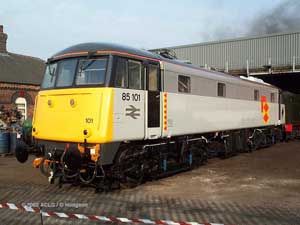|
|
Forty new AC electric locomotives were ordered from British Railways Doncaster Works, together with forty sets of electrical equipment from AEI. With AEI having already supplied equipment for the AL1s and AL2s it was not surprising that much of it was standard with these types (particularly AL1), making a semi-standard fleet of 65 or 75 locomotives. The first AL5 to enter traffic from British Railways' Doncaster works was E3057 in the first week of June 1961. E3056 (numerically the first) did not appear for another two and a half months. E3057 was also the 51st AC electric to be delivered, thus marking the half way point for the initial orders. Deliveries of AL5s were spread over the next three years, with the last, E3095, going into traffic in the last week of 1964, only six months ahead of the first AL6 (Class 86). Initially the class was allocated to the general AC Lines code, and thereafter to Longsight, followed, in 1973 by allocation to Crewe Electric Depot.
Not having been plagued by the problems of earlier types, the AL5s led a fairly uneventful early existence. They differed from the other types by the addition of rheostatic braking (as applied to AL3 E3100), but this fell out of use until the late seventies when it was reinstated. Following repainting into standard Rail Blue, the class operated on classic mixed-traffic turns until the late eighties and early nineties, earning itself the honour of being "Britain's most boring class" at one point! Despite regular turns on anglo-scottish Inter City services, none were ever officially named, although 85030 was bestowed with the unofficial name "Fell Runnner" for a short time - an apt name for a locomotive which spent many years hauling trains across the fells of northern England and southern Scotland.
In 1989, Railfreight Distribution identified the need for more AC electric traction, and with late delivery of Class 90s, the decision was made to convert ten Class 85s to dedicated freight locos. This entailed removal of their train heating, reducing their maximum speed, and reclassifying as Class 85/1. The first loco chosen, no. 85006, was renumbered 85101 in 1989, with the remainder of the class following over the next few months. The locos suffered the same problems in later life as did the Class 81s, and fires were commonplace. Four further Class 85/1s were converted to replace locomotives so damaged. By the end of August 1991, however, the end was in sight for even these locomotives. A farewell railtour The Roarer Requiem, with 85101 and 85105 providing the traction, had already been run, and with the new Class 90/1s entering traffic the remaining 85s were finally withdrawn. Four locos were assigned to empty carriage stock duties (85101 and 85040 at Euston, 85110 at Liverpool Lime Street and 85018 at Manchester Piccadilly - 85113 later joined the Euston locos) but these duties were surprisingly short-lived, as by December 85101 and 85113 had been withdrawn, and the class had become extinct.
Almost the entire class ended up in Crewe's electric graveyard, where they remained for well over twelve months before disposal began. In December 1992, Pete Waterman purchased 85104 (previously 85012 and E3067) for preservation. This loco was returned, however, when Mr Waterman discovered that much of the internal cabling in this and other withdrawn locos had been attacked and destroyed since purchase - allegedly carried out by persons intent on the class not being returned to service in place of faulty Class 90s. Mr Waterman was able to acquire 85101 in its place however, and completely intact - apparently the perpetrator of the crime was on holiday!
The rest of the Class journeyed in groups of three locomotives to MC Metals in Glasgow for scrapping.
 85101 at Barrow Hill
85101 at Barrow Hill